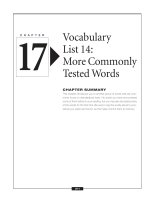Slide and Slurp, Scratch and Burp: More About Verbs (Words Are Categorical) potx
Bạn đang xem bản rút gọn của tài liệu. Xem và tải ngay bản đầy đủ của tài liệu tại đây (4.83 MB, 34 trang )
by Brian P. Cleary
illustrated by Brian Gable
THIS PAGE
INTENTIONALLY
LEFT BLANKVerb: A word
that shows
action or being
To Isabella
—B.P.C.
by Brian P. Cleary
illustrated by Brian Gable
MILLBROOK PRESS / MINNEAPOLIS
J
4
s
n
e
a
k
a
n
d
s
n
i
f
f
,
s
n
e
e
z
e
a
n
d
s
e
i
z
e
a
n
d
w
h
e
e
z
e
a
n
d
w
h
i
f
f
.
Verb
s
are words like
5
P
l
an
t
ing carro
t
s,
ge
tt
ing
t
rac
t
ion,
Ver bs give sen
t
ences
their action.
You migh t be exp
l
oring
the Alps or the Amazon,
maybe
re
s
t
oring
t
h
e
c
h
a
i
r
t
h
a
t
y
o
u
r
g
r
a
n
d
m
a
’
s
o
n
,
6
kn
i
tt
i
ng or h
i
tt
i
ng
or roping or b
i
t
i
ng—
v
e
r
b
s
c
a
n
m
a
k
e
s
e
n
t
e
n
c
e
s
v
e
r
y
e
x
c
i
t
i
n
g
.
t
h
a
t
n
u
z
z
l
e
a
n
d
n
i
p
,
They
t
e
ll
us of horses
8
and birds as they sip.
of bears as
they
guzzle
They tell us of scooters
bo
th
and stopping,
throws that are curving
or sliding or d
r
o
p
p
i
n
g
.
9
s
w
e
r
v
i
n
g
So wrap a package,
t
ie a knot,
clap your hands,
10
T
r
i
u
m
p
h
,
t
r
e
m
b
l
e
,
o
r
c
r
y
a
l
o
t
.
you’ll use a
v
erb
for each example!
11
t
r
o
t
,
a
n
d
t
r
a
m
p
l
e
,
F
l
y
t
o
t
he flower shop,
dash
t
o
t
he dance,
12
s
w
i
n
g
b
y
t
h
e
s
w
i
m
m
i
n
g
p
o
o
l
,
frolic in France.
Without
v
erbs,
your sentence
can’t go anywhere.
13
S
o
a
r
t
o
t
h
e
c
i
r
c
u
s
a
n
d
f
l
o
a
t
t
o
t
h
e
f
a
i
r
.
Each sen
t
ence has a subjec
t
—
i
t
’s kind of like
t
he s
t
ar.
It’s whatthe whole thing’s
all about:
15
D
a
v
e
’
s
d
i
s
h
,
M
o
m
’
s
l
o
o
k
,
T
o
d
d
’
s
c
a
r
.
Subjects always need a verb—
16
i
t
’
s
w
h
a
t
m
a
k
e
s
f
i
s
h
e
s
s
w
i
m
and lanterns li
gh
t
and writers wri
t
e
and clippers cut and
t
rim.
17
They “link” instead of “do,”
con
n
ect
i
ng sentence parts, as in,
18
S
o
m
e
v
e
r
b
s
a
r
e
n
’
t
t
h
e
a
c
t
i
o
n
k
i
n
d
—
“
Y
o
u
r
d
o
g
a
p
p
e
a
r
s
q
u
i
t
e
b
l
u
e
.
”
These linking
v
erbs
c
o
n
n
ec
t
a subject
to a word or phrase
that’s called a
subject co
m
p
l
e
m
ent.
It’s done in lots of ways:
19
That strudel sure smells great.
I
t
b
e
c
a
m
e
r
i
d
i
c
u
l
o
u
s
.
20
T
his
play
see
m
s second rate.
The cri
m
e remains a mystery.
21
The forms of “be”
are linking verbs,
22
l
i
k
e
,
“
A
r
e
y
o
u
r
n
a
m
e
s
M
i
c
h
e
l
l
e
?
”
23
Were and
w
as
w
ork this way, too—
they’re forms of “be” as well.









